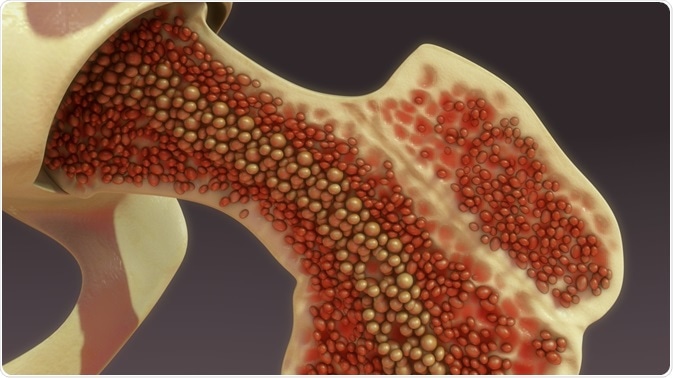Skeletal stem cells give rise to bone and cartilage both prenatally and postnatally. As a fundamental part of development, the study of skeletal stem cells and their role in skeletal physiology makes them an important area of study for human health.

Image Credit: sciencepics/Shutterstock.com
Bone marrow and stem cells
Skeletal stem cells form part of the bone marrow stroma, where they contribute to bone growth, bone modeling, and bone remodeling during life. In addition to this, they help produce adipocytes the cells that make up adipose tissue during growth and bone marrow remodeling, form cartilage, regulate the microvascular network, regulate osteoclasts, and maintain the hematopoietic microenvironment necessary for growth.
Skeletal stem cells exist in the bone marrow environment as perivascular cells on the outer side of the bone marrow’s endothelial lining.
However, the definition of skeletal stem cells is somewhat controversial, with conflicts based on criteria used for isolation and detection and on the similarity of mesenchymal stem cells and skeletal stem cells.
Skeletal stem cells and their lineages
Skeletal stem cells were first discovered in the 1960s when bone marrow transplants were found to form ectopic ossicles comprised of multiple types of skeletal tissue. These stem cells were found to be capable of giving rise to cartilage, bone, and adipocytes in vivo.
The ways in which skeletal stem cells give rise to other cells are called their skeletal lineages. Cartilage, bone, stroma, and marrow adipocytes are all types of cells resulting from the skeletal stem cell lineages and develop at different times during human development. The first to develop are cartilage, followed by bone, stroma, and lastly adipocytes.
Bone development, also known as osteogenesis, most commonly occurs via endochondral ossification. Here, rudimentary cartilage is replaced by bone and bone marrow from within by skeletal stem cells.
How skeletal lineage is decided
Three main transcription factors determine developmental commitment to cartilage, bone, and adipocytes. For cartilage development, Sox9 (sex-determining region Y box 9) is the master transcription factor. For bone development, it is Runx2, and for adipocytes, it is PPARy2 (peroxisome proliferator-activated receptor y2).
The levels of the three main transcription factors are in turn controlled by the TGFβ/BMP superfamily, Wnts, and hedgehogs, and are as such tightly linked to body growth and development. These controls act on homeoboxes to control transcription levels, such as the Msh homeobox to increase Runx2 expression and thereby induce bone formation. Bone development is also promoted by Wnt stimulation of Runx2
BMP, in addition to acting on the Msh homeobox, upregulates Sox9 and thereby aids in cartilage formation. Hedgehog signaling indirectly reduces Runx2, which then allows for cartilage, instead of bone, induction. Opposite to this, Wnt prevents cartilage induction.
Production of adipocytes is induced via CCAAT enhancer-binding protein, which upregulated PPARy2. These two engage in a positive feedback loop to keep levels of both high. Wnt can inhibit adipocyte production by inhibiting the CCAAT enhancer-binding protein while promoting Runx2.
The use of skeletal stem cells in medicine
Due to their stem cell potential and the many great conditions associated with poorer bone organ health, skeletal stem cells have received considerable attention. That said, most of the research focusing on skeletal stem cell activity has been carried out in the context of the bone marrow stroma.
One of the ways in which skeletal stem cells are hypothesized to potentially be useful for the treatment of conditions is as progenitors for bone tissue engineering. They can also potentially be used as non-progenitors by assisting in the assembly of microvessels and networking, and as good models of disease in stem cell-based models.
Lastly, they are also believed to be useful conceptually by showing changes that occur in tissues due to pathologies and dynamics in stem cell biology.
Further Reading